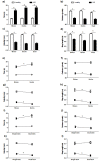The Danger of Walking with Socks: Evidence from Kinematic Analysis in People with Progressive Multiple Sclerosis
- PMID: 33138057
- PMCID: PMC7662955
- DOI: 10.3390/s20216160
The Danger of Walking with Socks: Evidence from Kinematic Analysis in People with Progressive Multiple Sclerosis
Abstract
Multiple sclerosis (MS) is characterized by gait impairments and severely impacts the quality of life. Technological advances in biomechanics offer objective assessments of gait disabilities in clinical settings. Here we employed wearable sensors to measure electromyography (EMG) and body acceleration during walking and to quantify the altered gait pattern between people with progressive MS (PwPMS) and healthy controls (HCs). Forty consecutive patients attending our department as in-patients were examined together with fifteen healthy controls. All subjects performed the timed 10 min walking test (T10MW) using a wearable accelerator and 8 electrodes attached to bilateral thighs and legs so that body acceleration and EMG activity were recorded. The T10MWs were recorded under three conditions: standard (wearing shoes), reduced grip (wearing socks) and increased cognitive load (backward-counting dual-task). PwPMS showed worse kinematics of gait and increased muscle coactivation than controls at both the thigh and leg levels. Both reduced grip and increased cognitive load caused a reduction in the cadence and velocity of the T10MW, which were correlated with one another. A higher coactivation index at the thigh level of the more affected side was positively correlated with the time of the T10MW (r = 0.5, p < 0.01), Expanded Disability Status Scale (EDSS) (r = 0.4, p < 0.05), and negatively correlated with the cadence (r = -0.6, p < 0.001). Our results suggest that excessive coactivation at the thigh level is the major determinant of the gait performance as the disease progresses. Moreover, demanding walking conditions do not influence gait in controls but deteriorate walking performances in PwPMS, thus those conditions should be prevented during hospital examinations as well as in homecare environments.
Keywords: T10MW; accelerator; gait analysis; inertial sensor; kinematics; multiple sclerosis; surface EMG.
Conflict of interest statement
The authors declare no conflict of interest.
Figures



Similar articles
-
Clinical assessment of gait in individuals with multiple sclerosis using wearable inertial sensors: Comparison with patient-based measure.Mult Scler Relat Disord. 2016 Nov;10:187-191. doi: 10.1016/j.msard.2016.10.007. Epub 2016 Oct 27. Mult Scler Relat Disord. 2016. PMID: 27919488
-
Step to the beat: Auditory-motor coupling during walking to higher and lower tempi with music and metronomes in progressive multiple sclerosis: An observational study.Mult Scler Relat Disord. 2024 Dec;92:106152. doi: 10.1016/j.msard.2024.106152. Epub 2024 Nov 1. Mult Scler Relat Disord. 2024. PMID: 39522464
-
Wearable sensors can reliably quantify gait alterations associated with disability in people with progressive multiple sclerosis in a clinical setting.J Neurol. 2020 Oct;267(10):2897-2909. doi: 10.1007/s00415-020-09928-8. Epub 2020 May 28. J Neurol. 2020. PMID: 32468119 Free PMC article.
-
Contributions to the understanding of gait control.Dan Med J. 2014 Apr;61(4):B4823. Dan Med J. 2014. PMID: 24814597 Review.
-
The use of laboratory gait analysis for understanding gait deterioration in people with multiple sclerosis.Mult Scler. 2016 Dec;22(14):1768-1776. doi: 10.1177/1352458516658137. Epub 2016 Jun 30. Mult Scler. 2016. PMID: 27364324 Review.
Cited by
-
Wearable Sensor Technologies to Assess Motor Functions in People With Multiple Sclerosis: Systematic Scoping Review and Perspective.J Med Internet Res. 2023 Jul 27;25:e44428. doi: 10.2196/44428. J Med Internet Res. 2023. PMID: 37498655 Free PMC article.
-
Smart Sensors for Healthcare and Medical Applications.Sensors (Basel). 2021 Jan 14;21(2):543. doi: 10.3390/s21020543. Sensors (Basel). 2021. PMID: 33466591 Free PMC article.
-
Intensive Neurorehabilitation and Gait Improvement in Progressive Multiple Sclerosis: Clinical, Kinematic and Electromyographic Analysis.Brain Sci. 2022 Feb 12;12(2):258. doi: 10.3390/brainsci12020258. Brain Sci. 2022. PMID: 35204021 Free PMC article.
References
-
- Institute of Medicine (US) Committee on Multiple Sclerosis . In: Current Status and Strategies for the Future. Multiple Sclerosis: Current Status and Strategies for the Future. Joy J.E., Johnston R.B. Jr., editors. National Academies Press; Washington, DC, USA: 2001. - PubMed
MeSH terms
Grants and funding
LinkOut - more resources
Full Text Sources
Medical

